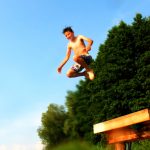
One of the reasons we chose Schloss Leizen for Germany For Kids was its beautiful location in the “Mecklenburgische Seenplatte” or Mecklenburg Lake District, sometimes known as the land of 1000 lakes.
In reality there is closer to 300 lakes here, the largest of which is the Müritz, the biggest lake to fall entirely within Germany. The whole area is renowned for its wildlife not just in the lakes which holds many species of freshwater fish including Char, huge Catfish, Salmon and even Sturgeon, but the aquatic nature of our local landscape harbours many rare birds, fish hunting eagles like the Osprey and White Tailed Eagle, plus Bittern, Cranes and recent arrivals Great White Egrets.

This unique habitat is the reason we have the Müritz National Park which includes the whole eastern side of the Muritz and many thousands of acres of surrounding marsh, forests and smaller lakes. The Muritzeum in nearby Waren is the largest freshwater aquarium in Germany and celebrates the diverse flora and fauna of the region.
The lakes were formed about 10,000 years ago at the end of the last ice age, as the glaciers retreated water was trapped in melt-water valleys by glacial morraine dams and remains today.
Many of the larger lakes are joined by canals, making the whole area a popular boating destination, it is possible, in fact, to travel by boat all the way to Berlin. There are also canals joining the lakes within the National Park, however motorboats are banned here, this is why we take our kids on canoe-safari here, paddling safely amongst the plants and animals of this wilderness.

Closer to Schloss Leizen our local lakes are the Dambecker See, half a mile from our doors and the Tangahnsee a 3 mile hike or cycle ride on off-road paths. Both lakes, like most in the area, boast EU certified “Excellent” water quality status making them ideal for swimming, boating and fishing.

In winter the lakes freeze over for at least a few weeks a year, ice hikes and skating is possible, we apply very strict rules when skating, we only skate in areas where the water is no more than knee depth, when the ice is thick, in approved areas and never alone.

Take look on Google maps to see just how many lakes we have.




